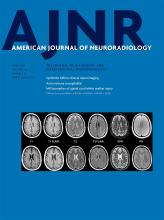Endovascular thrombectomy has become a valuable part of the treatment of patients with an acute large vessel occlusion in the anterior circulation. High rates of quality reperfusion after endovascular thrombectomy were considered a key element for achieving superior functional outcomes compared with sole medical treatment with IV rtPA.1 Because a reperfusion grade of TICI 2b or better has been shown to be a precise and reliable predictor of good functional outcomes, TICI 2b and 3 are conventionally considered as “successful reperfusion.”2 In their highly relevant article, Dargazanli et al3 provided further evidence that the outcomes of patients with “complete” (TICI 3) reperfusions are significantly better as opposed to patients with “near complete” (TICI 2b) reperfusions.4
These results not only underscore the need for devices that minimize the occurrence of periprocedural thrombus fragmentation potentially accountable for incomplete reperfusions, but also raise the important question of whether interventionalists should strive to achieve TICI 3 reperfusion in cases where TICI 2b is already achieved (“luxury rescue”).
Recent studies have suggested that it is technically feasible to reach and recanalize smaller, distal MCA branches when encountered as the primary occlusion site. However, evidence for a clinical benefit of endovascular thrombectomy versus IV rtPA in treating distal occlusions beyond the proximal M2 level is lacking.
Notwithstanding, risk-benefit ratios might differ in the scenario of already achieved TICI 2b reperfusions. First, catheter placement is already taking place, which, relatively speaking, diminish the general risks of endovascular treatment (eg, groin hematoma). Second, available therapy alternatives are limited when TICI 2b reperfusion has already been achieved because the option of administering IV rtPA is usually no longer available.
The study by Dargazanli et al3 supports the notion that a more aggressive treatment approach in striving to achieve TICI 3 reperfusions might be of benefit. Because “luxury rescue” maneuvers (eg, using IA lytics or small stent-retrievers) may inherit the risk of jeopardizing the already achieved benefit of a TICI 2b reperfusion, the evaluation of such maneuvers with regard to technical feasibility, safety, and clinical benefit is highly desirable.
Footnotes
Disclosures: Johannes Kaesmacher—UNRELATED: Grants/Grants Pending: KKF (Technical University Munich)*. *Money paid to the institution.
References
- © 2017 by American Journal of Neuroradiology












